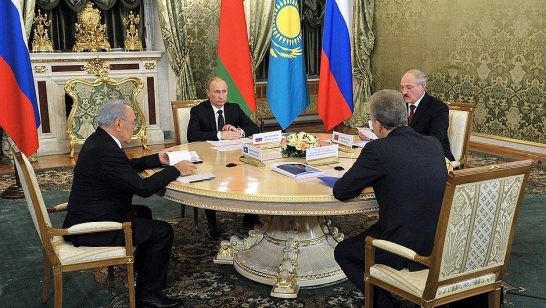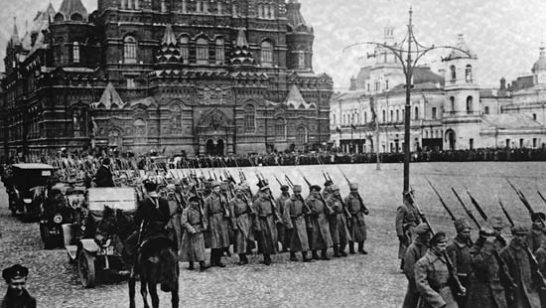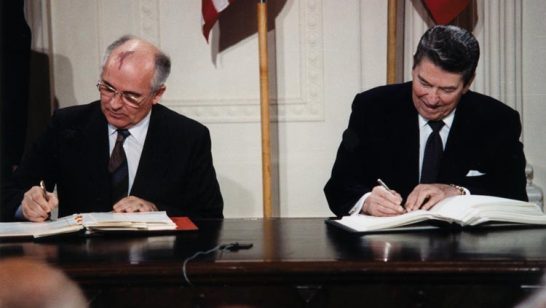
In July 2014, the U.S. State Department released its annual Compliance Report and accused Russia of violating the Intermediate Nuclear Forces (INF) Treaty. At a time when U.S.-Russian relations have been severely damaged by Russia’s annexation of Crimea and continued interference and threat of military intervention in Ukraine, these violations are extremely troubling and could have significant long-term implications for European security. While some have advocated a U.S. withdrawal from the Treaty, and perhaps a commitment to develop and deploy U.S. missiles, such a decision would be both premature and self-defeating. Instead, the Obama administration should focus on Russia’s diplomatic transgressions and aggressive overreach to galvanize the NATO alliance and confront Russia with a single, unified Euro-Atlantic coalition.
Signed in Washington in December 1987, by U.S. President Ronald Reagan and Soviet Secretary General Mikhail Gorbachev, the INF Treaty was a diplomatic watershed. For the first time, an entire class weapons—ground launched, intermediate-range (500-5500km), ballistic and cruise missiles—were removed from the arsenals of the Superpowers and scrapped under a novel intrusive on-site inspection program. The Treaty contributed to the effective stabilization of European security. While it has an almost “taken for granted” quality today, the removal of these weapons allowed for a secure political-military environment in which German reunification, EU integration and NATO expansion could take place. The Treaty remains in effect today with both the United States and Russia agreeing to forego the development, production, and deployment of intermediate-range systems, whether armed with nuclear or conventional warheads.
U.S. experts have been concerned with Russian missile developments for some time. Two systems have emerged as potential violations of the INF Treaty. The R-500, which was explicitly highlighted in the report, is a ground-launched cruise missile (GLCM) that can achieve ranges over 500 km, thus violating threshold proscribed by the Treaty. The R-26 ballistic missile has been claimed to possess intercontinental range by Moscow, and thus allowed as an ICBM under the New START Treaty. However, U.S. experts argue that Russia has conducted several tests of the missile at ranges less than 5500km, the minimal range for ICBMs. So while the R-500 seems to be a clear formal violation of the letter of the Treaty, as a conventional cruise missile, it may be less threatening than the R-26, which represents a more serious violation of the spirit of the Treaty. Some argue that the R-26 replicates many of the capabilities of the Soviet-era SS-20, a highly-capable, nuclear-armed, intermediate-range ballistic missile (IRBM) which stoked fears in Western Europe and drove European leaders to request an American/NATO response in the late 1970s.
With Russia’s aggressive behavior in recent months, the absence of intermediate-range nuclear forces limited the potential escalation dynamics that could emerge from a clash between Russian and NATO forces. While many of the Central European NATO members are within the range of shorter-range missile systems, most of Western European has not had to fear the threat of a potentially rapid nuclear missile attack since the end of the Cold War. It may be difficult to measure the contribution of the Treaty today, but clearly the European security environment is much more stable than one in which opposing nuclear-armed missile forces could launch a devastating first strike, with little warning time. Consider the downing of the Malaysian Airlines Flight 11 by Ukrainian separatists. In an environment more like early 1980s, such a dramatic and horrific event could have initiated a severe crisis that, in the presence of intermediate-range systems, would have been much more dangerous.
To underscore the potential dangers of Russia’s violations, over the past decade, Russia’s strategic doctrine has focused on the use of nuclear forces to “de-escalate” a conventional regional conflict in which an outside power (e.g. NATO) has intervened in a territory deemed vital to Russia’s strategic interests. Due to the perceived weakness of Russia’s conventional fighting forces, the use of nuclear weapons has taken on a greater role. In fact, a scenario like the current conflict in Ukraine seems troublingly close to the kind that Russian forces have war-gamed and planned for in exercises under Medvedev and Putin. In fact, for some time Russian officials have expressed displeasure and frustration at the limitation of the Treaty on Russian forces when many neighboring countries (or those that could target Russian soil) possess these very weapons (China, Iran, India, Pakistan, North Korea).
Nonetheless, Putin seems to have forgotten many of the lessons of his predecessors. In agreeing to the INF Treaty, Gorbachev followed through on the realization that hard-line Soviet policies had proven self-defeating. Rather that providing a favorable “correlation of forces” from which Russia could extract political concessions from NATO members and potentially drive a wedge between the United States and Europe, the SS-20 deployment galvanized the alliance against the Soviets Union. Moreover, with the subsequent U.S. deployment of Pershing-II IRBMs, and nuclear-armed GLCMs, Soviet policy had in fact decreased Russia’s security. Soviet leadership and command and control targets could be struck from Europe. Sacrificing the SS-20 for the removal of Pershing-II and GLCM actually improved the security of the Soviet Union, and also served as a major signal of Gorbachev’s intentions to forge a new relationship with the West.
In considering a U.S. response to Russia’s violations, what is particularly interesting about the Cold Was U.S. decision to deploy INF forces to Europe was the limited perceived military value U.S. leaders saw in these weapons. Arguing that extended deterrence could be maintained by other existing strategic systems, many in the Carter administration were ambivalent about a new American intermediate-range ballistic missile. The deployment of Pershing II and GLCM was a political rather than military move. Calls for developing and deploying costly new U.S. INF forces now will provide little additional military benefit to the United States but could greatly complicate the security environments confronting key allies in Europe and Asia.
If Moscow has indeed violated the INF Treaty and plans to deploy R-26 and R-500 in European part of Russia, then it has unilaterally altered the security environment in Europe and constitutes a direct threat to NATO states. Western European states, particularly Germany and France, should work closely with Washington, London and other alliance members to devise a comprehensive and effective response. They should be prepared to take concrete actions to punish Russia’s transgressions even if economic sanctions cause pain for struggling EU economies. Further cooperation on missile defenses and upgrading NATO member military forces may also be prudent. It may be true that no one wants another Cold War in the United States or Europe. Unfortunately, judging by his actions in Crimea and Ukraine, it seems that Vladimir Putin is willing to risk a dramatic downturn in relations with the West to satisfy his hyper-nationalist, aggressive foreign policy in Russia’s near abroad. As in the past, NATO must work to devise a robust, unified response to the security threat of Russian missiles to deter further provocations and reverse Putin’s dangerous policies.
The opinions articulated above represent the views of the author(s), and do not necessarily reflect the position of the European Leadership Network or any of its members. The ELN’s aim is to encourage debates that will help develop Europe’s capacity to address the pressing foreign, defence, and security challenges of our time.



